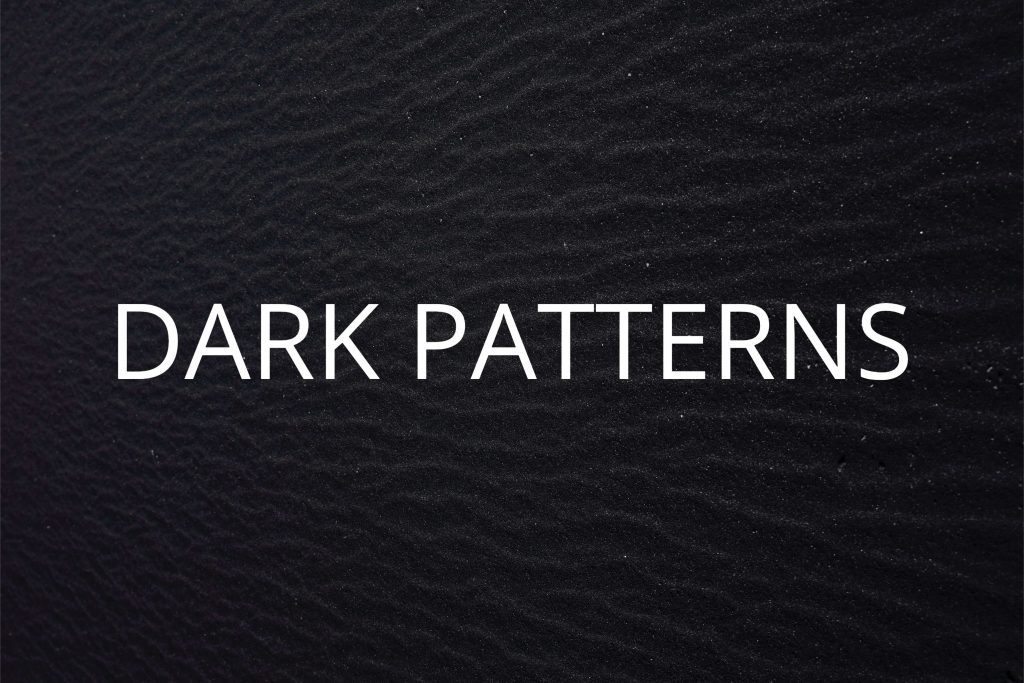Dark Patterns – Introduction

PART I
This is the first post in a series that will tackle the issue of Dark Patterns, and how they influence us as customers and consumers. Stay tuned for future additions to this series if you want to learn more about this subject.
Introduction
Great design should be based both on creating the best experience for users, and meeting business objectives. Bad design usually tackles only one of these perspectives. Finding the extremely narrow line of equilibrium between merging user and business objectives can bring great challenges toward (UI/UX) designers. This is why a great designer can marry the concept of awesome user experience and met objectives on the service side.
The aim of this initial post is to provide a better understanding to anybody interested in what makes a great design. The chapter has been structured based on the principle of via negativa — explaining a subject not by what it should be, but by what it should not. In this spirit, great design will be explained not by what it should be, but by what it should not: design tactics colloquially called in the industry, dark patterns.
Disclaimer: Some images may contain obscuring rectangles or other altered elements, in order to avoid copyright infringement, under a mild artistic license; some names may be modified or removed altogether to serve the same purpose.
What is a Dark Pattern?
Wikipedia provides a short but concise definition to inform us that “a dark pattern is ‘a user interface that has been carefully crafted to trick users into doing things, such as buying insurance with their purchase or signing up for recurring bills.”
Furthering this definition, we can say that a dark pattern is “a user interface that has been carefully crafted to trick users into doing things, such as buying insurance with their purchase or signing up for recurring bills”, in order to further business objectives at the expense of users. Some dark pattern designers have got their craft to such a refined level that they exploit human psychology into obtaining the desired results.
Dark patterns are not entirely bad, as they sometimes can transform into anti-dark patterns.
What are Anti-dark Patterns?
Anti-superheroes are like superheroes, in that they are the main characters of their story, but without conventional qualities such as courage, moral idealism and an affinity for justice.
Anti-dark patterns can be thought of as an analogy to anti-superheroes. As opposed to dark patterns, anti-dark patterns can serve a useful purpose, in that they can not only meet the objectives of the business, but also align with the user’s (unknown) needs.
This type of UI/UX pattern usually happens unintentionally, and it can sometimes provide an extra revenue for businesses and happy customers. Purposefully crafting an anti-dark pattern is, by definition, not intentional. The reason is because if businesses would craft a dark pattern into both meeting the business’s and the user’s objective, it would not be a dark pattern anymore; it would meet the gold standard.
Every type of dark pattern, presented in the next section, can unintentionally and organically transform itself into an anti-dark pattern, without the knowledge of the constituents of the transaction, the service and the user. Anti-dark patterns cannot be contained or exploited, they are a purely arbitrary event.
Dark Pattern types
This section will elaborate on the most widespread dark patterns that can be found online. Disclaimer: the examples applied in this section may not apply anymore, but the underlying philosophy of each pattern remains the same.
At the end of each section, our insight will be provided in order to tackle these dark patterns. As a foreword, a general rule of advice for every dark pattern type presented here, will not be added to each section, as it is deemed to be common sense, and that is: try to avoid them.
Bait and switch
Bait and switch dark patterns “advertise a free (or greatly reduced) product or service which is wholly unavailable or stocked in small quantities. After it is apparent the product is no longer available, they are exposed to other priced products similar to the one advertised”.
Or, in other words, the user intends to do one action, agrees to it, but the action itself does something completely different than the proposed information to which the user has given his agreement to.
This kind of dark pattern is most famously used when different programs or operating systems request the user to update to a newer version. Usually, they start innocently enough, presenting some of the most impressive features of the new version of the software in a non intrusive way.
As time goes by, and the user decides not to update, the update pop-up or screen gets increasingly aggressive towards the user.
One famous example regards a famous operating system’s update campaign. Users who were using a previous version initially received an honest pop-up, displaying some of the main benefits of upgrading, and an optional set of actions that could be done with the pop-up (accept the upgrade, schedule the pop-up, exit from the pop-up etc.).
As time went on, the pop-ups got increasingly and visibly more aggressive. The pop-up would automatically schedule a time for the upgrade process to start, and the user would have to manually change the schedule (they could not cancel the scheduling altogether); the iconic “X” quit button had its action changed. The button, unbeknownst to users, would now actually mean “yes, I agree to upgrading my PC to the new operating system”, which caused massive outrage within the computing world. This backlash caused the company to reevaluate its upgrade policy to to the new OS, as their aggressive campaign in trying to persuade users to upgrade, backfired. One theory that emerged is that in order to continue the upgrade campaign, but also to mitigate further outbreaks from enraged users, the company toned done the intensity of the update requests, but made users know that ultimately, their computers will automatically upgrade to the new OS.
Mobiversal’s advice against Bait and switch:
- Make sure you use clear and concise phrasing
- Make sure your call to action is phrased in such a way so that it matches the actions the user can do
- Try to avoid using an intrusive tactic. For an update, structure it in such a way so that the user is provided with multiple options to schedule the time for an upgrade
- Avoid using other types of dark pattern when creating the UI, such as misdirection
- Do not forcefully update to a new version without having the user consent. Try to inform him of the benefits of upgrading and downside of not upgrading.
That’s it for now. Hopefully, you’ve learned a thing or two about how dark patterns get to influence our decisions, unconsciously. Tune in next week, when we will elaborate on another form of dark patterns, Confirmshaming.
- Part I – Introduction
- Part II – Confirmshaming
- Part III – Disguised ads & Forced continuity
- Part IV – Friend Spam & Hidden Costs
- Part V – Misdirection, Price Comparison Prevention & Privacy Zuckering
- Part VI – Roach motel & Sneak into basket
- Part VII – Trick questions & Fake new notifications
Notes
- Dark pattern – Wikipedia. https://en.wikipedia.org/wiki/Dark_pattern.




